HIAS Statement on Pittsburgh Shooting
[unable to retrieve full-text content]
tech2 News Staff Jan 31, 2019 18:28:55 IST
The top three brands that took over the premium market segment in the fourth quarter (Q4) of 2018 were OnePlus, Apple and Samsung with an overall contribution of 92 percent as per Counterpoint Research.
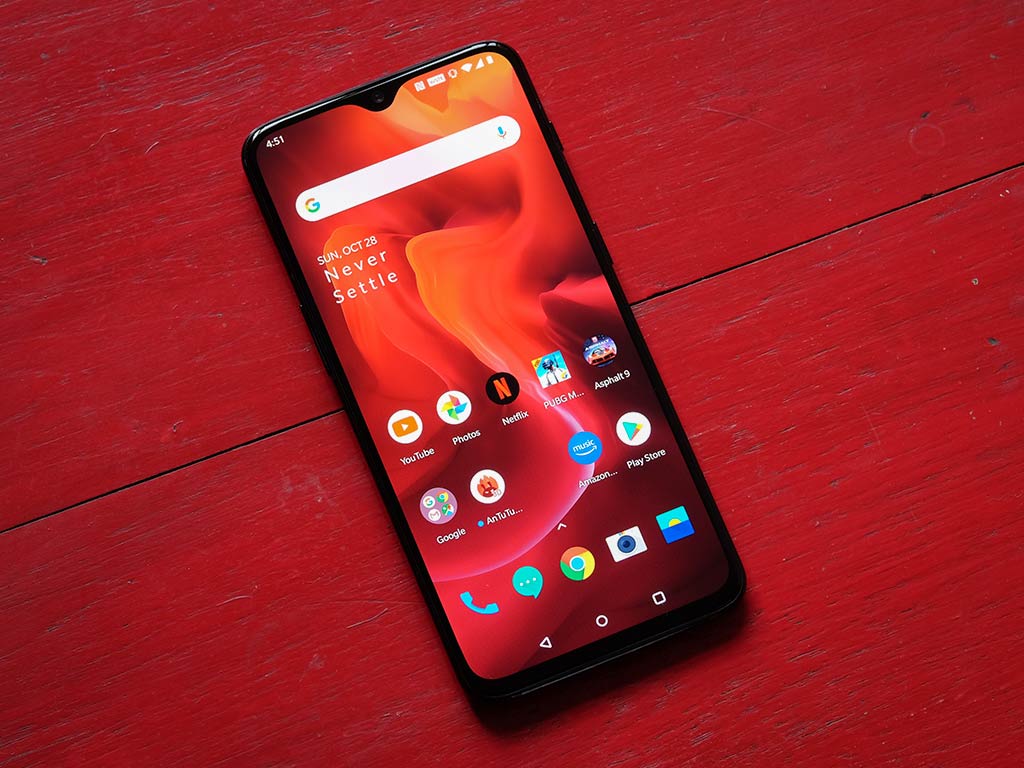
The OnePlus 6T starts at a price of Rs 37,990. Image: tech2
OnePlus captured 36 percent of the market share for the fourth quarter of 2018 which places the company at the leadership position for three consecutive quarters in 2018.
Also, the report declared the company flagships, OnePlus 6 and OnePlus 6T to be first and the second highest selling smartphones in 2018 respectively. The OnePlus 6T was followed by Samsung S9 Plus.
[embedded content]
Samsung was seen to capture 26 percent share of the premium segment in Q4 2018. The newly launched Galaxy A9, world’s first quad rear camera phone attributed towards Samsung’s growth and was in direct competition with OnePlus.
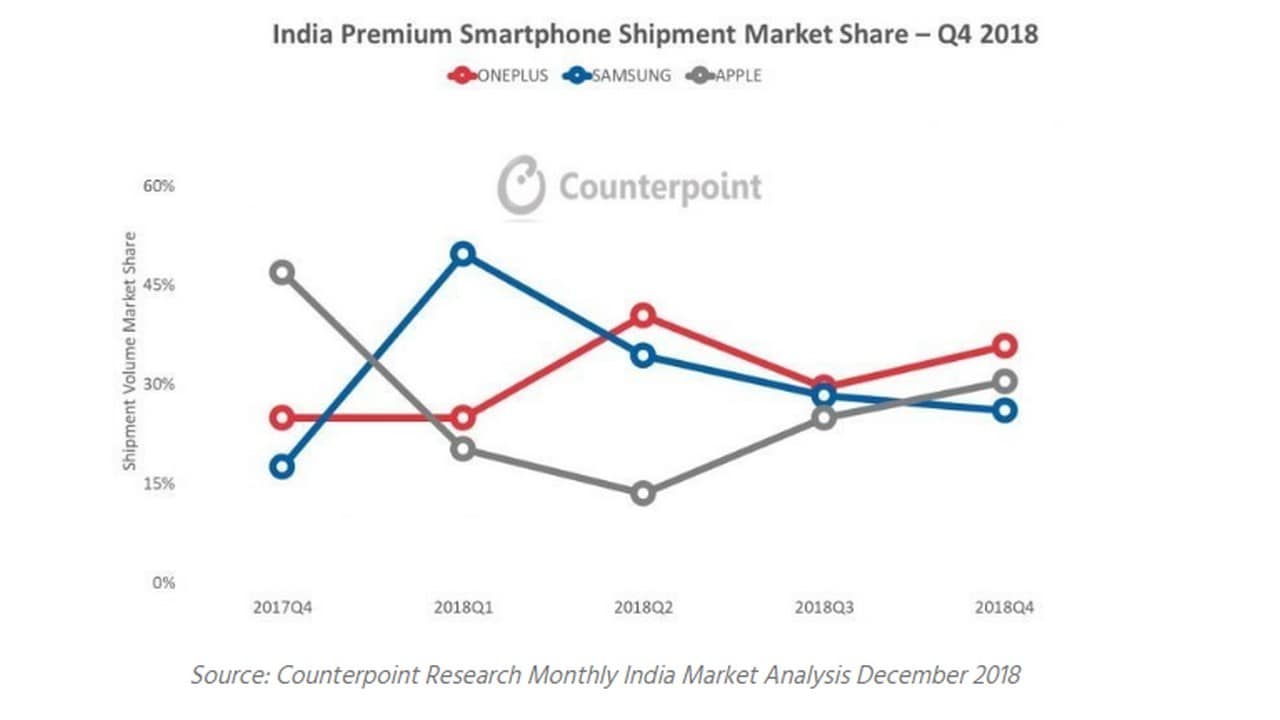
India’s premium smartphone shipment market share. Image: Counterpoint Research
However, Samsung was seen to lead just by one percent in the premium market in terms of shipments for the whole of 2018. Samsung contributed 34 percent to the shipment market, OnePlus 33 percent and Apple ten percent.
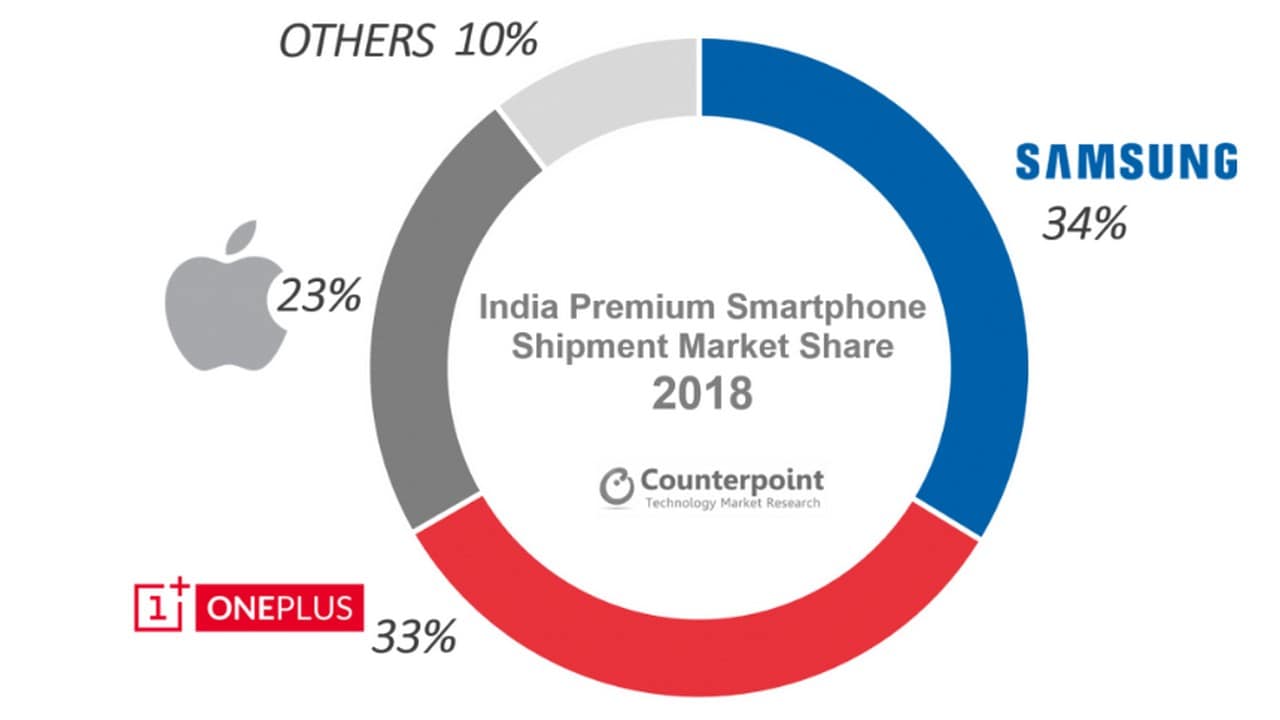
Samsung is seen to lead just by one percent in the premium market in terms of shipments. Image: Counterpoint Research
Where Samsung was seen to get a shipments growth of 72 percent YoY in Q4 2018, Apple’s premium segment shipments declined to 25 percent YoY in Q4 2018. This decline is attributed to Apple’s high-priced smartphones (Apple iPhone XS Max was rolled out for Rs 1,44,900).
[embedded content]
Tech2 is now on WhatsApp. For all the buzz on the latest tech and science, sign up for our WhatsApp services. Just go to Tech2.com/Whatsapp and hit the Subscribe button.
They have to struggle to keep the funding processed, they have to compete with established firms and keep the business-operation costs controlled. They are more focused on core business activities like increasing brand awareness and team productivity for better quality, and cut costs wherever necessary.
I have seen many startups that choose to handle the finances themselves and hire teams of finance executives, resulting in a greater cost for the company than what they would spend if they had outsourced accounting services. Outsourcing to an individual or a company allows you to pay for day-to-day transactional work and the support you get from their accounting department.
For many, outsourcing is related to only IT services, but the trend has changed in a past few years. Now, more business operations are being outsourced to India as the experts in India offer services at affordable pricing. Global businesses are now outsourcing administrative tasks, customer service, human resources and marketing needs to the service providers. Bookkeeping and accounting is no exception.
It is the process of hiring an individual or a firm, specializing in offering accounting services in India, to take care of all your accounting service needs at affordable pricing. The hired professional will manage your financial activities while working from his (or her) remote location.
Outsourcing is now a growing trend that enables small firms and start-ups to get the required accounting services and skills to grow in the cut-throat marketplace, without any significant investment of hiring the in-house finance teams. So, if your business is growing and you need someone to take care of your bookkeeping needs, but you do not want to invest in your own or extra equipment, outsource accounting to a trusted firm.
Not just it saves a lot of your time and cost that you would spend on handling the finances yourself, but also plays an important part in your brand growth. There are many key ways the decision can give you major advantages as you grow:
It’s true that most start-ups and small companies initially ignore the importance of bookkeeping, and then panic when they have to deal with the tax-related issues. Various legal problems may be faced if you are not ready with proper “bookkeeping files”. Dealing with a professional outsource bookkeeping company from the start helps you develop maintain good business habits that support your growth. You have better control over your expenses and know where your business stands financially.
Additionally, your outsourced accounting partner may also teach you about the “Ins” and “Outs” of bookkeeping so you know everything about the financial matters of your company and its growth.
You’ll Make Better Financial Decisions
In the beginning, you have to handle everything and invest on various business operations. Instead of spending like crazy, your offshore partner firm will be your support to prioritize everything related to finances. They don’t make financial decisions that are based on assumptions, but prepare plans and craft solid strategies, based on facts.
Who knows your startup turns out to be among the fortune 1000 companies in the following few years. With the growth, changes your bookkeeping needs as well. You may just need monthly accounting services today, but you may seek comprehensive daily accounting services as your company grows.
Instead of handling a major transfer from a small part-time in-house finance executive to an accounting firm later, you can stay stick to your outsourcing accounting service provider who can handle your needs now and in future.
Over 70% of businesses that outsource their accounting services admit that they opt to outsource because it offers an entire team of accounting experts on their side. And with access to pool of specialists, outsourcing to India is gaining more popularity at global level. These experts have worked with various businesses, which means they can support your business growth with comparative and critical analysis.
They know the insights of the industry and are familiar with what your company should prepare for, what financial solutions may be better, how to make better spending choice, etc. For your growing business.
Outsourcing your company accounting needs to a professional firm may be a great way to deal with increasing expenses and to reduce costs on operational process. If you think whether or not it will work for your company, it probably will! Not just the startups, but the established firms are also considering to transfer their accounting management to the outsourcing service companies to grow their businesses and make smarter decisions.
Starting at the early stage will support your company’s financial health and serve as a strong foundation for your business growth.
About the Author:
Shubham, I’m currently working as Finance Executive with Fintax Experts. I am passionate about driving high growth metrics while also improving operating efficiency. I have worked in a number of business-facing finance roles firms. I have the keen interest in supporting a complete Finance systems implementation project.
tech2 News Staff Jan 31, 2019 16:25:24 IST
The humungous Mi Max phablet series from Xiaomi could soon be having a fourth smartphone joined to the list called the Mi Max 4 along with an upgraded version of the device called the Mi Max 4 Pro. As per the leaks, it looks like Xiaomi will be adopting the water drop notch on both the phones.
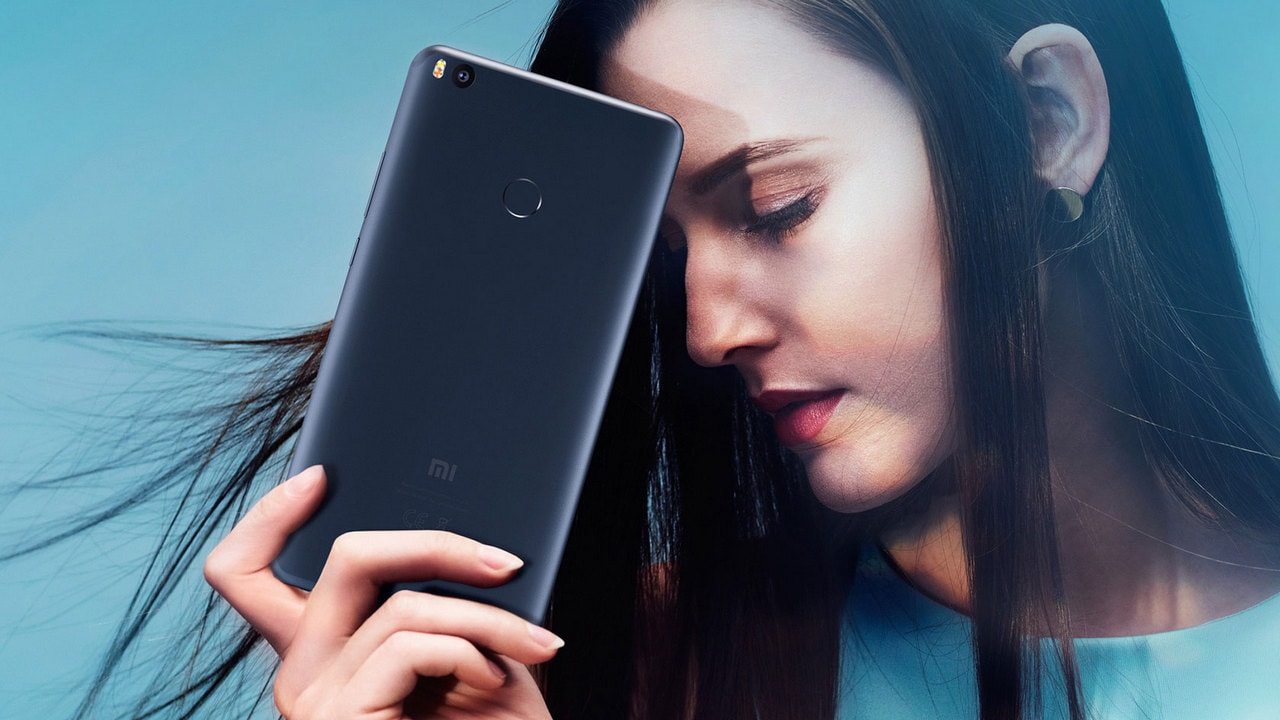
Last year’s Xiaomi Mi Max 2. Image: Xiaomi Global
The Chinese social media website Weibo was the source of the photo which gave specification details of the Mi Max 4 and Mi Max 4 Pro. The source in question has been reliable before and therefore the chances are high that these specs could be true.
The Mi Max 4 is said to include 7.4-inch IPS LCD panel which comes with a waterdrop notch. The front and back of the device are said to come with Gorilla Glass 5 on both the sides. On the inside, the phone is powered by a Snapdragon 660 chipset along with 4 GB and 6 GB RAM and 64 GB and 128 GB internal storage respectively. The optics on the phone could likely be the same as the Redmi Note 7 which has the Samsung GM1 48MP sensor.
The Mi Max 4 Pro has also said to have the same 7.2-inch waterdrop-notch style display. However, on the inside, the phone is said to come with the Snapdragon 675 SoC, and will have not the Samsung sensor but the Sony IMX586 sensor with 960 FPS slow-motion support. Although the Mi Max 3 didn’t end up coming to India, lets hope the Mi Max 4 does.
Tech2 is now on WhatsApp. For all the buzz on the latest tech and science, sign up for our WhatsApp services. Just go to Tech2.com/Whatsapp and hit the Subscribe button.
[unable to retrieve full-text content]
Reuters Jan 30, 2019 15:43:36 IST
US-based electronic cigarette company Juul Labs Inc is hoping to launch its products in India by late 2019, a person familiar with the strategy told Reuters, marking one of its boldest bets to expand away from its home turf.
After recruiting Uber India executive Rachit Ranjan as a senior public policy strategist, Juul this month hired India-based Mastercard executive Rohan Mishra as head of government relations.
It plans to hire at least three more executives, including an India general manager, LinkedIn job postings showed. It also plans “a new India subsidiary”, according to one posting.

Juul e-cigarette starter pack. Reuters
“It (the plan) is currently at an exploratory stage, but the company needs people on the ground in India,” the source said.
Juul’s sleek vaping devices, which resemble a USB flash drive and offer flavours such as mango and creme, are a sensation in the United States but have drawn tighter regulatory scrutiny due to surging use among teenagers.
Juul devices, like most electronic cigarettes, vaporize a liquid containing nicotine, the addictive stimulant that gives smokers a rush.
Advocates for the devices say that they are far less of a health threat because users don’t inhale the dangerous matter taken into the lungs through cigarette smoking.
Opponents argue the devices still involve addictive chemicals and can be a gateway to cigarette smoking, especially for the young.
The push to launch in India is part of the company’s broader Asia strategy. India has 106 million adult smokers, second only to China in the world, making it a lucrative market for firms such as Juul and Philip Morris International Inc.
However, India’s regulatory environment for tobacco and electronic cigarettes is highly restrictive. The health ministry last year advised states to stop the sale or import of e-cigarettes, saying they pose a “great health risk”. Eight of India’s 29 states currently ban e-cigarettes.
Juul is studying central and state regulations that could block its plans, the source said, adding that it would engage with the medical community to build acceptance for the devices.
Juul said in a statement India was among the Asian markets under evaluation, but there were no “definitive plans”.
“As we explore potential markets, we are engaging with health regulators, policymakers and other key stakeholders,” the company said.
Medical Journal
As part of its evaluation, Juul said it would consult with the Indian Journal of Clinical Practice (IJCP), a healthcare communications company.
One of the journal’s editors is a former president of the Indian Medical Association, K.K. Aggarwal, who has publicly voiced his support for e-cigarettes.
The IJCP will advise Juul on the regulatory landscape and offer advice on how it should approach the market, a second person familiar with the plans said.
Juul would face competition from leading players in India’s $10 billion cigarette market – ITC and Godfrey Phillips – which sell such electronic devices as well.
India’s vapour-products market was valued at only $15.6 million in 2017, according to Euromonitor International, but it is expected to grow by nearly 60 percent a year up to 2022.
Juul could be “potentially very attractive” to the growing number of young and wealthy smokers in India, said Shane MacGuill, Head of Tobacco Research at Euromonitor International.
Altria Group last month paid $12.8 billion to take a 35 percent stake in Juul, a move expected to boost the company’s international growth prospects.
Philip Morris is also considering a launch of its heat-not-burn tobacco device iQOS in India, which it says is less harmful than conventional cigarettes, Reuters reported last year.
Tech2 is now on WhatsApp. For all the buzz on the latest tech and science, sign up for our WhatsApp services. Just go to Tech2.com/Whatsapp and hit the Subscribe button.
[unable to retrieve full-text content]
Reuters Jan 30, 2019 16:02:20 IST
A Canadian government decision on whether to ban Huawei Technologies Co Ltd from supplying equipment to 5G networks is “some ways off into the future yet”, a top official said on Tuesday.

Canadian government mulling on the decision over whether to ban Huawei 5G. Image: Reuters
The comments by Public Safety Minister Ralph Goodale to reporters were the most specific indication yet from Ottawa on the timing of a politically sensitive announcement.
Officials are studying the security implications of 5G networks, the latest generation of cellular mobile communications. Some Canadian allies have already imposed restrictions on Huawei equipment, citing the risk of espionage.
“It’s some way off into the future yet … it’s certainly beyond weeks,” Goodale said when asked about the timing.
Canada and China are involved in a separate diplomatic dispute over the arrest of Huawei Chief Financial Officer Meng Wanzhou last month in Vancouver on a U.S. arrest warrant.
Tech2 is now on WhatsApp. For all the buzz on the latest tech and science, sign up for our WhatsApp services. Just go to Tech2.com/Whatsapp and hit the Subscribe button.
It’s fair to say Avast Secure Browser delivers on all three pledges. We here at FileHippo have had a play around with it, examining all its exciting features, to find that out for ourselves.
The browser’s architects describe it as ‘your passport to the web’, no less. It was created as they felt it was time to stop the internet, and your browsing, being exposed and vulnerable.
“As experienced engineers of consumer security products, Avast strives to secure every aspect of the users’ digital life,” Avast say, in a frank summary of the product.
[embedded content]
“Since most of us spend an increasing portion of those lives online, we’ve focused on transforming the power of our world-leading software expertise into a simple, secure, all-in-one browser.”
Has Avast delivered on these big promises? We think so, and in this review we will explain why. It will also give you the full run-down and tutorial of the browser’s key features.
The main point to stress is the common theme that you’ll notice as we assess the three Ps. That’s the great usability and friendly interface offered by Avast. Early praise must go to its dedicated Security and Privacy Center, it keeps users protected, informed and secure online.
Simply put, this is what makes Avast Secure Browser unique. Here you will be able to easily control settings and features that not only ensure privacy, protection and performance – but also make cybersecurity an enjoyable experience too.
“Friendly and simple, it allows new and experienced users alike to easily find and control security settings,” add Avast. “In short: we make the complex simple and let the user make the browser their own.”

So, lets get started, and where better to kick-off our review than by looking at the browser’s privacy features directly? Avast understand that staying private while browsing online is ‘almost impossible’ these days. Nonetheless some impressive features have been installed to keep your digital life under wraps.
Firstly, Avast breaks the mould of other browsers by having most privacy features switched on by default. It also makes it clear to users where these can be found and adjusted. Meanwhile scripts following your online activity are automatically blocked, thanks to Avast’s Anti-Tracking feature.
Stealth Mode makes sure that tracking cookies or web caches picked up while browsing are chucked, browsing history is also not saved. This handy tool can be accessed from the top of the browser and can also activate Anti-Phishing, Anti-Tracking and HTTPS Encryption tools.
Moreover, Avast’s Anti-Fingerprinting tool halts sites from using a unique browser profile to identify a user. This means lots of information like add-ons, browser version and language settings can be kept private. However, by default this feature is switched off, as it could ‘break’ some websites.

Privacy Cleaner also steps in to keep activity hidden, while also cleaning up disk space. It does this by carrying out a swift tidy up of cookies, cached images and browser history – as well as other rubbish that doesn’t have to be there!
Overall, with Avast Secure Browser your identity and digital footprint will always be concealed. The product’s built-in privacy features will mean that no one can track you. Your posts, emails, searching and browsing history are yours, and yours only.
Avast understand that our browsers are ‘more vulnerable than ever before’. That’s why their Secure Browser is jam-packed with standout features and tools to make sure you can be as protected as possible.
It uses the most up-to-date version of Chromium. This means a ‘strong, secure and trusted’ platform is guaranteed. Avast Secure Browser also has everything users need to enhance security built-in from the get-go. Other browsers usually reply on third-party extensions, but not Avast’s product!
As we’re all aware, growing interest in cryptocurrencies and attacks on personal banking accounts are a by-product of the digital age. It’s scary stuff, and Avast has brought in a string of features to directly defend against this type of cybercrime.
Anti-Tracking tech will thwart third-party scripts and keep browsing habits private. This means your CPU will be safe, and your performance will also be enhanced. Bank Mode is available too, protecting users from password hackers, crypto-hijacking and malicious keypad logs. Dangerous and unsafe browser extensions are also stopped, thanks to Extension Guard capabilities.
Online banking is safe again when you use Bank Mode, part of Avast Secure Browser.
Bank Mode prevents hackers from seeing what you type so they cannot steal your passwords, credit card numbers, and other personal data. Download for free here ➤ https://t.co/DD3VldepfD #privacy pic.twitter.com/U1ClUMeG0R
— Avast Software (@avast_antivirus) January 10, 2019
If that wasn’t enough, Flash Protect is another big plus. As well as hogging computer resources and killing battery life, Flash opens devices up to several security vulnerabilities. With Flash content also becoming practically extinct, thanks to the rise of HTML5 alternatives, Avast have decided to bring in this feature. Don’t worry, this can similarly be adjusted from the central hub.
Overall, Avast Secure Browser provides all the features needed to prevent identity theft, malware and phishing scams. It can block malicious websites and downloads, preventing your PC getting infected by spyware, ransomware and viruses. Meanwhile it also includes a safe and secure password manager. Complete protection.
You would think that having come up trumps on privacy and protection features, the security experts would be pretty content with their package. Yet, Avast didn’t stop there!
Thanks to the automatic blocking of adverts there is less to load, which means everything gets sped up! Avast’s Adblock can be switched on and off with the click of a button at the Security and Privacy Center.

Meanwhile, Avast Secure Browser has received a lot of compliments on its user interface. The straightforward and effective Security and Privacy Center keeps you fully informed, while also not being too evasive.
Increased clarity, transparency and ease of use is apparent thanks to the clutter-free UI. Avast say this reduces the friction usually caused by prolonged use. As we said before, the browser is built on Chromium, the most secure and fastest platform out there – so that helps too!
Additional perks, like the Video Downloader feature, are available as well. This tool allows the downloading of all sorts of media and supports popular sites like DailyMotion and Vimeo.
Overall, the architects at Avast could have easily rested on their laurels after creating a browser rich in privacy and protection features – but they went further. Because of the modifications made and the blocking of ads you get a very seamless experience. Everything is carried out in one place too, which allows ease of access without completely baffling you with decisions.
We all know that there is an embarrassment of riches out there when it comes to browsers these days. Though Avast has passionately defended the birth of ‘another browser’ when describing the product – and we think they have every right to do so.
Its creators say that we need a browser that is built with our ‘best interest in mind’. They promised that it would not follow the user each time that they clicked a link, used a search engine or bought something online. Again, it seems they’ve made good on this promise.
[embedded content]
Avast Secure Browser combines all the necessary security and privacy tools and stores them together in one familiar and friendly place. All the features and hacks homed within the Security and Privacy Center play a vital role in your browsing experience and safety.
You can manage Avast Antivirus and Avast SecureLine VPN, as well as other features like Privacy Cleaner and HTTPS Encryption from this handy hub. Yet, as if that wasn’t enough, Avast has also included other top features like its Video Downloader – complementing the experience, not just the practicality.
The bottom line? Not content with just delivering ‘the world’s leading antivirus’, Avast now claim to have created a ‘dream browser’. The experts pledge to go further than any other browser in terms of privacy, speed and security. They’re on their way to doing that.
Overall, as well as its far-reaching features and the fact it essentially allows you, the user, to be in control – it is also incredibly straightforward to use. A warm and friendly interface, coupled with handy tips and tutorials, makes Avast Secure Browser not only a safe experience, but an enjoyable one too.
[unable to retrieve full-text content]
tech2 News Staff Jan 30, 2019 18:25:19 IST
In the past few years, we have heard the likes of Samsung, LG, ZTE, Nokia, and Microsoft working on their foldable devices. In the last few months, we also saw Xiaomi, Oppo, and even Apple joining this league. However, the latest entrant to this bandwagon is a surprising one.
According to a patent filing, that was first spotted by LetsGoDigital, Intel quietly filed and was awarded a patent related to foldable devices back in June of 2017. This patent was filed under the title ‘Electronic device with foldable display panels’ on the World Intellectual Property Office (WIPO) and the United States Patent and Trademark Office (USPTO).
From what the patent describes, this foldable device will be a multi-purpose machine, that folds down in its smallest form to a pocketable phone. And from there, the device unfolds three times.

Concept drawings of Intel’s foldable display patent by LetsGoDigital.
The patent drawings show off three use case scenarios of the foldable device – a three-sided tent mode with all sides active, a traditional laptop mode with an on-display keyboard, and an e-reader format.
Essentially, the tablet consists of three display parts when unfolded, and each section comes with two cameras each i.e. six cameras in total. It also comes with a stylus pen that slides into the dents formed by the folds and is possibly held into place magnetically.
While this looks extremely exciting, the report also kills the buzz by saying that the patent may never see the light of the day. Here’s hoping it does!
Tech2 is now on WhatsApp. For all the buzz on the latest tech and science, sign up for our WhatsApp services. Just go to Tech2.com/Whatsapp and hit the Subscribe button.
tech2 News Staff Jan 30, 2019 11:06:49 IST
Gone are the days when Netflix and Hulu were the dominant force of the video streaming service business. With the rise of Amazon Prime and the upcoming streaming service from Disney, things are certainly looking to heat up. Now we are hearing that the little known standalone streaming service by Apple may be coming out this spring.

Apple. Reuters
As per a report by The Information, Apple has been telling several studios and networks, that its service will likely be ready for unveiling by mid-April. However, at this moment we are not sure how much Apple’s streaming service will cost users. Considering its Apple, you might have to prepare to shell out more than you would for perhaps Netflix or Amazon Prime. There is also no word on what Apple will be calling its streaming service.
April will also see Disney revealing to its investors what plans it has for its standalone streaming service. If Disney plans on launching its service by the end of the year and Apple is going for a Spring launch, then 2019 could offer an immense selection of streaming content for consumers.
As per The Verge, Apple has greenlit or begun developing an impressive slate of projects which include a multiyear deal with Oprah Winfrey to develop new shows, ordered a pair of children’s shows from the creators of Sesame Street, a reboot of the science fiction anthology show Amazing Stories, a Hunger Games-style dystopian show called See and more. We are sure to know more in the coming months.
Tech2 is now on WhatsApp. For all the buzz on the latest tech and science, sign up for our WhatsApp services. Just go to Tech2.com/Whatsapp and hit the Subscribe button.
[unable to retrieve full-text content]
tech2 News Staff Jan 29, 2019 17:13:16 IST
Motorola’s seventh-gen Moto G series’ design and specifications leaked in all its glory last week. While the alleged prices of Moto G7 Play and Moto G7 Power got leaked back then, the latest report now reveals the prices of the base model Moto G7 and its bigger variant, the Moto G7 Plus.
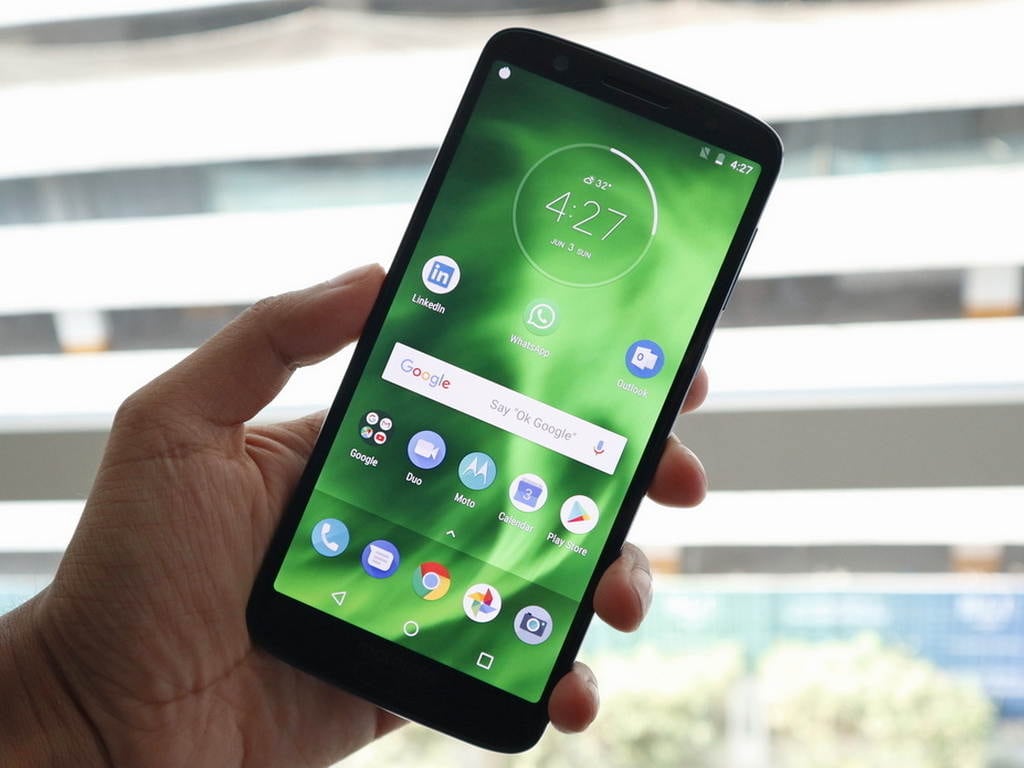
Representational image of Moto G6.
Tipster @ishanagarwal24 who earlier leaked the G7 Play and G7 Power’s price has now revealed the European price for the Moto G7 and G7 Plus on Twitter. The Moto G7 will come for a price starting at €300 (roughly Rs 24,420), while the Moto G7 Plus is said to cost €360 (roughly Rs 29,300). Alongside the prices, Agarwal also shared new renders of the purported Moto G7.
As per a GSMArena report, Motorola is hosting an event in Brazil where it is anticipated to introduce its new Moto G7 series. The new Moto G lineup is said to be showcased at MWC 2019 which is scheduled to take place in Barcelona next month.
EXCLUSIVE! I already told you the European pricing of Moto G7 Play and Power (€ 149 & € 209 respectively). Now, I have got my hands on the Moto G7 and G7 Plus pricing!
Moto G7- € 300
Moto G7 Plus – € 360European ppl happy with the pricing or not?#MOTOG7#Moto#Motorola pic.twitter.com/EE5E0sJl9k
— Ishan Agarwal (@ishanagarwal24) January 28, 2019
As far as specifications are concerned, the Moto G7 is said to feature a 6.24-inch full HD+ display, an octa-core Qualcomm Snapdragon 632 processor, 4 GB RAM and 64 GB storage. From what one can observe from the renders, the new Moto smartphone will most likely inherit the design language from the previous generation and carry the traditional dial-shaped camera module at the back.
A recently leaked listing revealed that the Moto G7 might come with dual rear camera setup comprising of a 12 MP primary sensor with f/1.8 aperture and 5 MP secondary sensor. It is said to have an 8 MP camera up front.
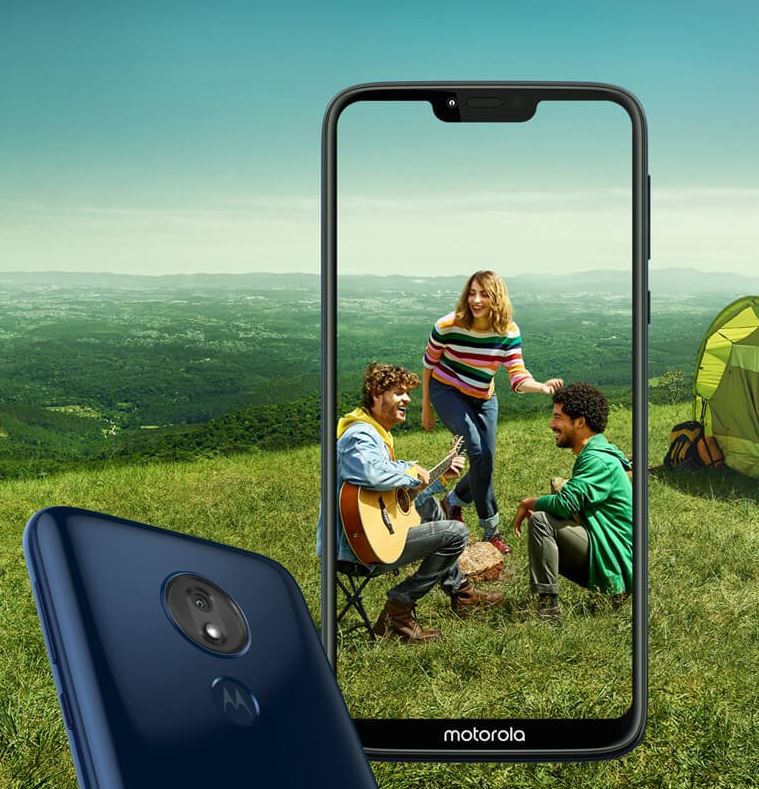
Moto G7 prices have been leaked online. Image: Twitter/@ishanagarwal24
The Moto G7 Plus is tipped to have a similar display resolution as the Moto G7. However, the phone is said to carry slightly upgraded Snapdragon 636 SoC instead of Snapdragon 632 chipset. Moto G7 Plus will come with 16 MP + 5 MP dual camera set up at the back and a 12MP front-facing camera for shooting selfies. Both the smartphones are rumoured to pack 3,000 mAh battery capacity.
As for the Moto G7 Power, recent leaked live images shared a fair glimpse of the new Moto phone. The phone reportedly spotted in a Brazilian retail store showcased the device housing a notch-style display. The phone is rumoured to carry a price tag of BRL 1,399 (around Rs 26,000) for the 3 GB RAM model. The leaked hands-on images reveal key aspects of the Moto G7 Power including a 6.2-inch HD+ Max Vision display, an octa-core 1.8 GHz processor, 12 MP primary camera and a 5000 mAh battery.
Tech2 is now on WhatsApp. For all the buzz on the latest tech and science, sign up for our WhatsApp services. Just go to Tech2.com/Whatsapp and hit the Subscribe button.
[unable to retrieve full-text content]
The Smartphone users are increasing every day and the devices have taken the job of fulfilling the shopping, news and entertainment demands of the user. This rise on the dependence of mobile phone for everyday activities has urged the app developers to bring intuitive and creative applications.
The mobile app development has turned its attention to develop apps which can accommodate payments, travel, booking of hotels and social networking. Mobile app development is dominating the future of technology with trendy and futuristic apps.
A decade ago, many enterprises have just started using the online platform to boost their business and mobile apps are still new as a marketing strategy. Coming to the present day, mobile apps became the center of businesses in all sectors like health, hospitality; entertainment, shopping and gaming, etc. mobile app development has entered into a new dimension of creativity where user’s experience and comfort is the foremost priority. The web applications have seamlessly integrated with mobile apps to carry out the business on the go.
Customized apps are developed to give power to the consumer on the preferences of the usability. Mobile app development is a never-ending and growing technology that experiments with the integration of new technologies and adapts to changes in trends on the go. The mobile app development has already entered into futuristic trends like augmented reality and Internet of Things (IoT), etc. Let us see all the changing trends with the latest technology integration in detail here.’
This is the latest technological trend which helps the users to control various devices at home with help of mobile phones. A smartphone connected through the internet is used to control the devices from a remote location. This comes handy to turn on music system or lights or heating system even before you enter the home. Mobile developers have collaborated with technology industries to make the life of users easier. Smartphones are now introduced with smart control which helps the user to turn on the TV, refrigerators, coffee makers and ACs from far.
Mobile wallets are the next best alternatives to carrying debit or credit card. To shop and pay bills, a lot of mobile apps are developed to make the user free from carrying any cash. A swipe of the mobile against barcode or scanning the QR code is now enough to make payments quick and cashless. Most of the businesses are now accepting mobile payments as a part of the digital era. The apps are secure and free from frauds to protect the money of the users and to keep the transaction legitimate.
Smartphones are currently the hub for innovative gadgets and wearable devices have been seamlessly integrated with the mobile network to take personalization to the next level. Heart rate monitors, sensors, geo-tagging, notifications, and calorie counting apps are directly linked to wearable devices like smart watches and fitness bands. Wearable devices communicate with the user by gathering information from the mobile network. This innovation has opened new opportunities for app developers and online entrepreneurs to stay in touch with consumers on a personal level.
Motion sensing technology has revolutionized the app development, especially in game development. Currently, the motion sensing technology is being leveraged by app developers for all categories of apps from games to health-related apps. Most of the mobile apps now are using the beacon or location-based services to provide immediate and relevant information to the users. It practically gives a competitive edge to the app developers and businesses linked to them to stay in close proximity to the users. Apps linked with GPS have a bunch of useful applications to the user for both personal and commercial purposes.
Though AR and VR are introduced into the market through gaming technology, their applications have been exploited and merged into various business applications in recent times. Retail shopping is using these technologies to bridge the gap between virtual and real products and thereby enhancing the consumer shopping experience. Some other industries which are picking up momentum in their businesses with help of AR and VR are education, real estate market, tourism departments, education institutions, marketing, and advertising firms.
Both AR and VR technologies are used to entice the mind of the consumer and bring in a new level of experience to their senses. VR apps bring in the trail room experience or shopping experience to the consumers in life-like simulations which save everyone a trip to the shopping malls and earn more time. These immersive experiences are the key to drive customer engagement to new heights and many apps are leveraging this technology to boost their business.
Web-related commerce needs cloud-based services to reduce the overload of servers. The digital workspaces and personalized apps are now moving to cloud-based mobile applications due to limitations in storage space and real-time access of files. Cloud-based apps allow access to the files from anywhere at any given time. Remote workspaces and group projects are all utilizing this technology to make their work easier. Backup and recovery services attract users to choose apps with cloud services. Having a cloud service app lets the user work from mobile or laptop and lets the user upload the files or transfer them in real time.
When you think of AI in mobile app development, Siri and other smart assistants come to mind. These personal assistants have changed the way how users communicate and do tasks. AI has taken over the functionalities like texting, answering questions, tracking down information much effectively with the integration of other Indian app Development Company trends. Voice interface is now part of every novel app that has made its transition into the digital era.
Few more technological advancements like the integration of chatbots into mobile apps without the need for intricate coding and instant apps installation on the surge of popularity. All these advancements are here to make the mobile user-friendly and improve the user experience with personalization. Speaking earnestly, the mobile application has managed to capture the attention of the users across the globe with innovative technology and is on the way to venture into new magnitude.
About the Author:
The article is written by Shubham Sharma, he is currently working as Content Manager with Adreno Technologies. He has a great passion for digital marketing and help small and medium-sized businesses improve their online presence and grow their revenue by formulating effective digital marketing strategies for them.
tech2 News Staff Jan 29, 2019 17:48:05 IST
Asus has started rolling out the Android 9 Pie update for the ZenFone 5Z smartphone in India. Asus had spoken about the update way back in November.
As per the company, the update has been made available to users via the over-the-air (OTA) mode.
Like all software updates, this too is expected to roll out in batches. But if you are getting extremely desperate to get a bite of the pie and cannot wait anymore for the OTA notification, you can try booting the update manually by going to the Settings, then selecting the About option and opening the System Update.

Asus ZenFone 5Z. Image: tech2
The update is over 1,080 MB in size. The phone is claimed to get an all-new contextual pop-up volume bar, a new Magnifier feature for easier copy-and-paste option along with an improvement in the overall system performance.
The Asus ZenFone 5Z was initially running on the Android 8.0 Oreo. It was introduced at the Mobile World Congress in February 2018 and had hit the Indian market by July 2018 at Rs 29,999.
There have been rumours about the Asus ROG and the Max Pro M1 expected to get the Android 9 Pie update as well.
[embedded content]
The ZenFone 5Z features a 6.2-inch SuperIPS FHD+ display, Qualcomm Snapdragon 845 chipset and at least 6 GB of RAM.
In terms of optics, it sports a dual-camera setup at the rear, which is a combination of a 12 MP and a 5 MP camera. Up front is an 8 MP sensor. Fueling the 5Z is a 3,300 mAh battery that supports Qualcomm’s QuickCharge 3.0.
If you are interested to know further about the phone, head here for our in-depth review.
Tech2 is now on WhatsApp. For all the buzz on the latest tech and science, sign up for our WhatsApp services. Just go to Tech2.com/Whatsapp and hit the Subscribe button.
tech2 News Staff Jan 29, 2019 15:14:40 IST
Sony is expected to reveal its line-up for the Xperia smartphones at the Mobile World Congress 2019. The Sony Xperia XZ4 has been one of the prominent smartphones in the rumour mill for some time now.
Recently a screenshot of the specs sheet of one of the upcoming Sony smartphone was spotted which laid out the entire specs of the phone, but there was no mention of the camera configurations.
The screenshot does not name which phone the specs belong to, but it is speculated to be of the Sony XZ4.

Leaked render of the Sony Xperia XZ4 Compact. Image: @onleaks/@compareraja
As per the report in Sumahoinfo, the screengrab reveals the mysterious phone to feature a 6.4-inch OLED display with an aspect ratio of 21:9. It is also said to support HDR, sport a display resolution of 3360 x 1440 pixels and come with a Gorilla Glass 5 protection. It might measure 167 x 72 x 8.2mm and weigh 191 grams.
Earlier rumours show the Sony XZ4 to flaunt a 21:9 display.
Further, the report mentions the phone to come equipped with a Snapdragon 855 SoC coupled with 6 GB of RAM and 128 GB storage. It might also carry support for the microSD card slot.
The phone is expected to run on Android 9 Pie and also feature a fairly large 4,400 mAh battery pack.
The specs sheet is claimed to be taken from a Chinese or Taiwanese edition of the official site of Sony Mobile.
The smartphone might be available in colours like black, silver, blue and deep purple and carry an IP68 certification. No clues on pricing yet, so we may have to wait it out till MWC begins.
Tech2 is now on WhatsApp. For all the buzz on the latest tech and science, sign up for our WhatsApp services. Just go to Tech2.com/Whatsapp and hit the Subscribe button.
[unable to retrieve full-text content]
tech2 News Staff Jan 28, 2019 17:01:54 IST
Xiaomi’s alleged Android Go smartphone, the Redmi Go recently appeared online. While several reports pointed out Xiaomi’s very first Android Go smartphone’s imminent launch in India, another Android Go from leading brand HMD Global might be in pipeline.

The Nokia 2.1. Image: HMD Global
The device supposedly called Nokia 1 Plus has been spotted online in the Google Play Console Device catalogue. Folks at XDA Developers who managed to unearth details about the alleged Nokia 1 Plus suggest that the phone runs Android 9 Pie (Go Edition). For those unaware, Android Go is an optimised version of Google’s Android OS designed for entry-level devices with low RAM capacity. The device with the code-name ‘ANT’ is said to be powered by a MediaTek processor.
As per the XDA Developers report, the purported Nokia 1 Plus features a MediaTek MT6739 processor and the chipset is paired with 1 GB of RAM. The processor is said to have four ARM Cortex-A53 cores and it is coupled with a 570MHz Imagination Tech PowerVR GE8100 GPU. The listing further reveals that phone to have a display resolution of 480 x 960 pixels.
In a related report, TigerMobiles citing ‘reliable inside source’ suggested that the Nokia 1 Plus will have dual-SIM support, Wi-Fi, Bluetooth, GPS and micro USB connectivity for charging. Notably, the Nokia 1 that was introduced last year came with similar pixel resolution and RAM capacity. The supposed Plus version isn’t expected to carry significant upgrade over its predecessor, however, reports indicate that the phone would have a larger footprint as compared to the Nokia 1.
Meanwhile, the Finnish company is gearing up to showcase its first flagship of the year, Nokia 9 PureView next month. HMD Global has already sent media invites for the same and it is expected to unveil the device at MWC 2019. The Nokia 9 Pureview is rumoured to take the hole punch display trend and said to feature a 5.99-inch PureView display with 2K resolution and HDR10 compatibility.
Tech2 is now on WhatsApp. For all the buzz on the latest tech and science, sign up for our WhatsApp services. Just go to Tech2.com/Whatsapp and hit the Subscribe button.
Samsung has announced the Galaxy M20 in a 3 GB RAM and a 32 GB storage variants, and a 4 GB of RAM and a 64 GB storage variant. The smartphone will come with the Samsung One UI, and support for Widevine L1 to let you play HD videos on Netflix and Amazon Prime.
Samsung’s very first India-focus lineup, the Galaxy M-Series is finally expected to launch at 6 pm today. The new series is expected to debut three new phones – the Galaxy M10, Galaxy M20 and Galaxy M30. The series is going to feature several Samsung firsts such as triple-rear cameras in a budget phone, Infinity-U and Infinity-V displays, and a 5,000 mAh battery.
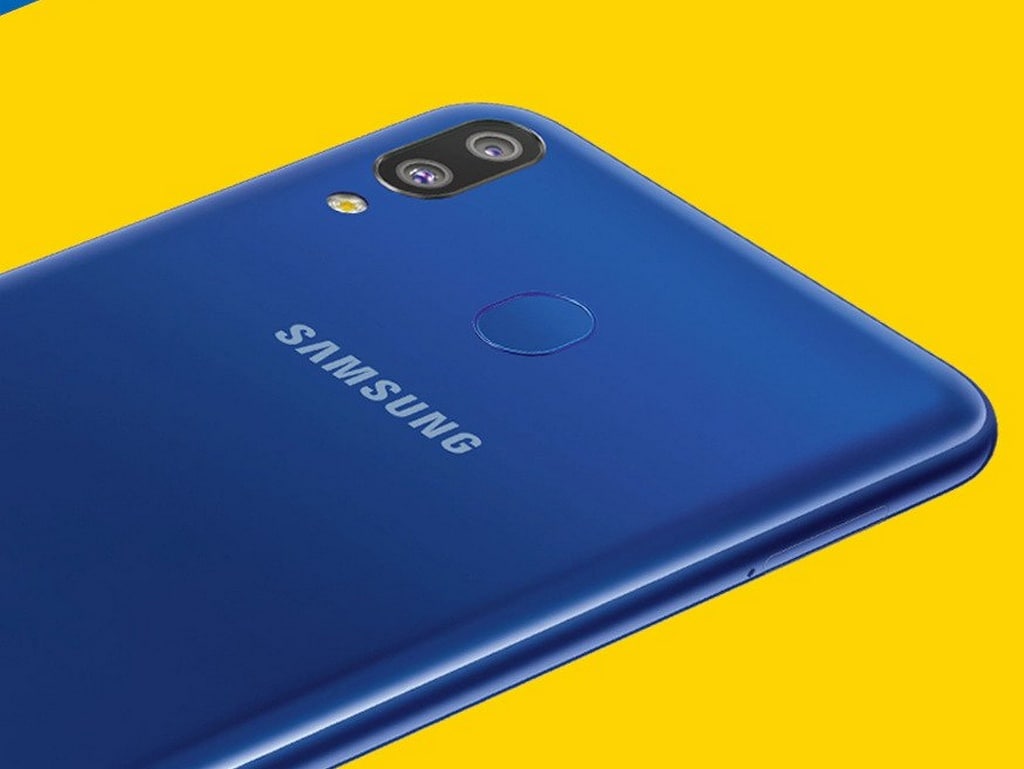
Samsung Galaxy M-Series
The series will also mark the debut of the company’s Exynos 7 Series 7904 processor. Pricing will be key for Samsung as it tries to play catch up with a number of Chinese smartphone brands including the likes of Honor and Xiaomi. From what we know, all the phones will be sold exclusively on Amazon starting 5 February.
Tech2 is now on WhatsApp. For all the buzz on the latest tech and science, sign up for our WhatsApp services. Just go to Tech2.com/Whatsapp and hit the Subscribe button.
[unable to retrieve full-text content]
Reuters Jan 28, 2019 15:25:09 IST
Search engine Bing’s outage in China last week was a technical error, rather than an intentional censorship block, a source familiar with the matter said, although Chinese authorities and Microsoft have not commented on the topic.
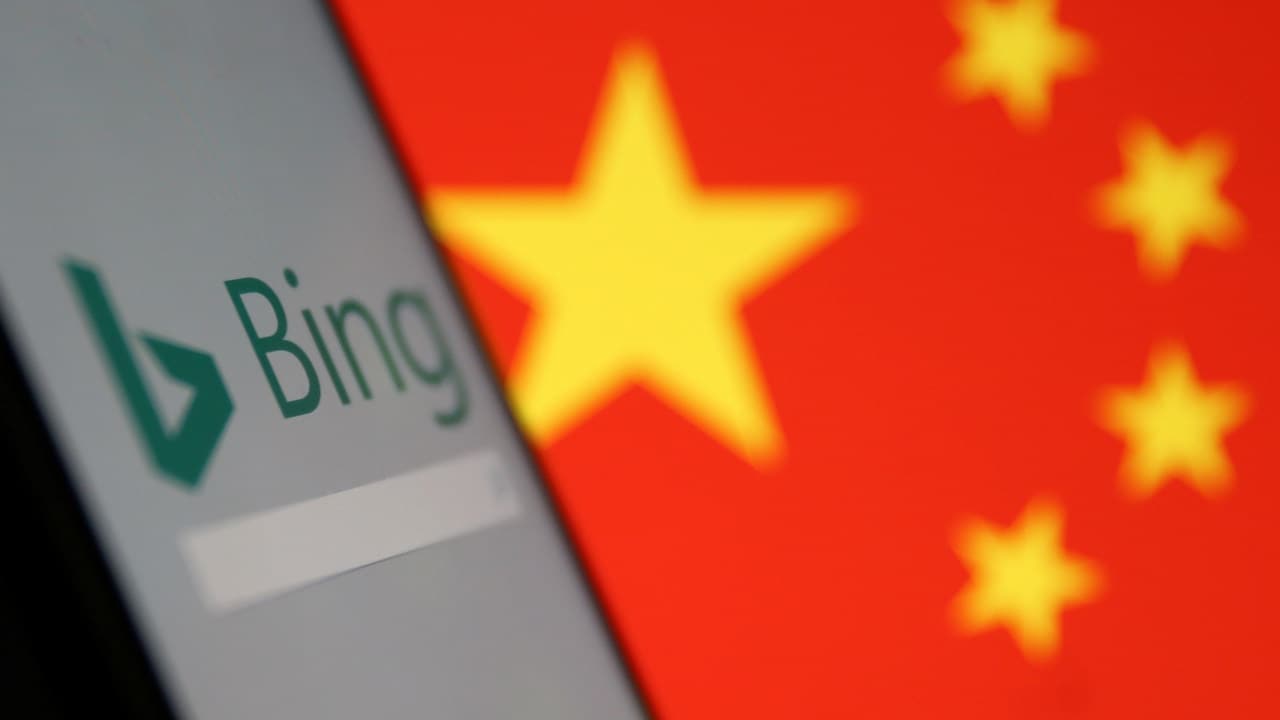
A smartphone with the Microsoft Bing logo is displayed against the backdrop of a Chinese flag. Reuters
From a technical perspective, a person at Microsoft Corp told Reuters, the site appeared to have been blocked in a manner similar to sites blocked by the government.
But the company had received no prior notice from authorities, and the disruption was not intentional on the part of the government, added the person, who declined to be identified, citing the sensitivity of the matter.
Microsoft was not immediately available for comment on Monday. Last week, although it confirmed the outage, it declined to give details.
The Cyberspace Administration of China did not respond immediately to a faxed request from Reuters seeking comment.
Starting from Thursday, Internet users in China attempting to access cn.bing.com, the search engine’s domestic URL, found themselves directed to an error page.
Attempts to log on to Facebook, Google search, or other sites blocked by China’s Great Firewall, encountered the same fate.
Service had resumed by late on Friday, however.
Engineers at ExpressVPN, a provider of virtual private network (VPN) software allowing internet users in China to access censored websites, ran tests during the outage to determine its origin.
They found that rather than domain name service (DNS) poisoning, the most common means for blocking sites under the Great Firewall, Bing’s outage appeared to employ a technique known as “black-holing”.
With this method, rather than re-directing to a dummy server traffic headed for a specific website, the traffic is simply cut off en route, usually at the internet service provider (ISP) level.
Express VPN Vice President Harold Li said blackholing boosts the likelihood of an accidental block, versus the more typical DNS poisoning, though he added that the company could not confirm the exact nature of the outage.
“We have no idea if it was an accident or not, but it’s much easier to make the mistake of blocking Bing when you’re blocking a set of IP addresses,” he said, referring to website addresses.
Bing has long been the only major overseas search engine accessible in China, which blocked access to Alphabet’s Google search platform starting in 2010. Microsoft alters Bing’s results to avoid politically sensitive topics, in line with government policy.
Bing’s outage came a day after a widely read article by a Chinese journalist criticizing the quality of search results from Baidu Inc, the dominant domestic search engine.
That led some internet users to speculate the two incidents were related. The company has endured regular public backlash since 2016, when a Chinese student died after seeking treatment at a hospital that advertised on Baidu.
Tech2 is now on WhatsApp. For all the buzz on the latest tech and science, sign up for our WhatsApp services. Just go to Tech2.com/Whatsapp and hit the Subscribe button.
Reuters Jan 26, 2019 11:40:56 IST
Smartphone makers in India are calling for export credits on devices and tariff cuts on machinery imports as part of measures they say will make Asia’s third-biggest economy a global smartphone manufacturing hub.
The I, (ICEA), whose members include some of the industry’s biggest names including Apple Inc, made the proposals in a 174-page document reviewed by Reuters and submitted to the government ahead of its annual budget announcement next week.
“As the country is nearing to achieve saturation point… without an export take-off manufacturing growth cannot be sustained and accelerated,” the ICEA said in the document.
The ICEA confirmed it submitted the document. The finance and technology ministries did not respond to requests for comment.

A worker arranges battery charger circuit boards at a mobile phone battery manufacturing plant in Noida. Image: Reuters
The government’s ‘Make in India’ campaign beginning 2014 and gradual tax increases on imports of mobile phone components have spurred the creation of more than 260 manufacturing units in the country and over 6,00,000 jobs, ICEA said.
That has helped India become the second-biggest producer of mobile phones after China, and prompted foreign smartphone makers such as Oppo and Samsung Electronics Co Ltd as well as contract manufacturers like Wistron Corp and Hon Hai Precision Industry Co Ltd (Foxconn) to ramp up production for phones primarily sold domestically.
The industry is now set for a further boost under a broader National Policy on Electronics currently in the works. Yet at the same time, the government also appears to be raising obstacles.
Next month, it will begin taxing imports of touch panels two months earlier than initially planned, sending mixed messages to handset manufacturers as setting up the means to assemble panels locally is a significant expense.
“Consistency in policy is important for any industry to mature,” said Navkendar Singh, associate research director at consultancy International Data Corp. “Back-and-forth in policy hurts investor sentiment and the country’s positioning as a destination to manufacture.”
In its document, ICEA proposed the government raise the export credit received on the value of mobile phone shipments to 8 percent from 4 percent. It also called for the introduction of a 5 percent export credit on services such as mobile apps.
Other proposals from the body – which also counts Huawei Technologies Co Ltd, Oppo and Foxconn among its members – include lower import taxes on capital goods such as machinery and ensuring manufacturers have access to low-cost capital.
“The next phase (of manufacturing) can now probably be driven by export incentives,” said Vikas Agarwal, India head of Chinese smartphone maker OnePlus, which is not an ICEA member.
“The eventual goal is to establish India as the preferred destination – and not just driven by duties, but by the opportunities in the Indian market.”
The ICEA, formerly the Indian Cellular Association, also called on the government to re-consider levying duties on new components, and allow for the local manufacture of parts already under the import tax regime to develop in a timely manner.
The import tariff on touch panels has been of particular concern to manufacturers including Samsung.
The South Korean firm has written to the federal government saying it cannot make two of its high-end models in India because of the tariff, the Economic Times reported this week.
A person familiar with the matter told Reuters Samsung had written to the government, and that the firm was investing in a touch panel assembly plant in India which would ready by the end of March 2020.
Samsung declined to comment.
The government aims to export $9 billion worth of mobile phones in the year ending March 2020 from just $100 million in 2017, the ICEA said in a previous report.
“Despite some improvement in exports since 2015, India still has a long way to become an export hub,” it said.
Tech2 is now on WhatsApp. For all the buzz on the latest tech and science, sign up for our WhatsApp services. Just go to Tech2.com/Whatsapp and hit the Subscribe button.
The Associated Press Jan 27, 2019 14:21:06 IST
Facial-detection technology that Amazon is marketing to law enforcement often misidentifies women, particularly those with darker skin, according to researchers from MIT and the University of Toronto.
Privacy and civil rights advocates have called on Amazon to stop marketing its Rekognition service because of worries about discrimination against minorities. Some Amazon investors have also asked the company to stop out of fear that it makes Amazon vulnerable to lawsuits.
The researchers said that in their tests, Amazon’s technology labeled darker-skinned women as men 31 percent of the time. Lighter-skinned women were misidentified 7 percent of the time. Darker-skinned men had a 1 percent error rate, while lighter-skinned men had none.

Representational image. Reuters
Artificial intelligence can mimic the biases of their human creators as they make their way into everyday life. The new study, released late Thursday, warns of the potential of abuse and threats to privacy and civil liberties from facial-detection technology.
Matt Wood, general manager of artificial intelligence with Amazon’s cloud-computing unit, said the study uses a “facial analysis” and not “facial recognition” technology. Wood said facial analysis “can spot faces in videos or images and assign generic attributes such as wearing glasses; recognition is a different technique by which an individual face is matched to faces in videos and images.”
In a Friday post on the Medium website, MIT Media Lab researcher Joy Buolamwini responded that companies should check all systems that analyze human faces for bias.
“If you sell one system that has been shown to have bias on human faces, it is doubtful your other face-based products are also completely bias free,” she wrote.
Amazon’s reaction shows that it isn’t taking the “really grave concerns revealed by this study seriously,” said Jacob Snow, an attorney with the American Civil Liberties Union.
Buolamwini and Inioluwa Deborah Raji of the University of Toronto said they studied Amazon’s technology because the company has marketed it to law enforcement. Raji’s LinkedIn account says she is currently a research mentee for artificial intelligence at Google, which competes with Amazon in offering cloud-computing services.
Buolamwini and Raji say Microsoft and IBM have improved their facial-recognition technology since researchers discovered similar problems in a May 2017 study. Their second study, which included Amazon, was done in August 2018. Their paper will be presented on Monday at an artificial intelligence conference in Honolulu.
Wood said Amazon has updated its technology since the study and done its own analysis with “zero false positive matches.”
Amazon’s website credits Rekognition for helping the Washington County Sheriff Office in Oregon speed up how long it took to identify suspects from hundreds of thousands of photo records.
Tech2 is now on WhatsApp. For all the buzz on the latest tech and science, sign up for our WhatsApp services. Just go to Tech2.com/Whatsapp and hit the Subscribe button.
tech2 News Staff Jan 27, 2019 14:40:21 IST
Software-based facial recognition has been around on Android smartphones for over a year now. But apart from a handful of smartphones, very few Android phones feature secure native facial recognition. Think Apple’s Face ID rather than Android’s existing ‘Trusted Face’ system.
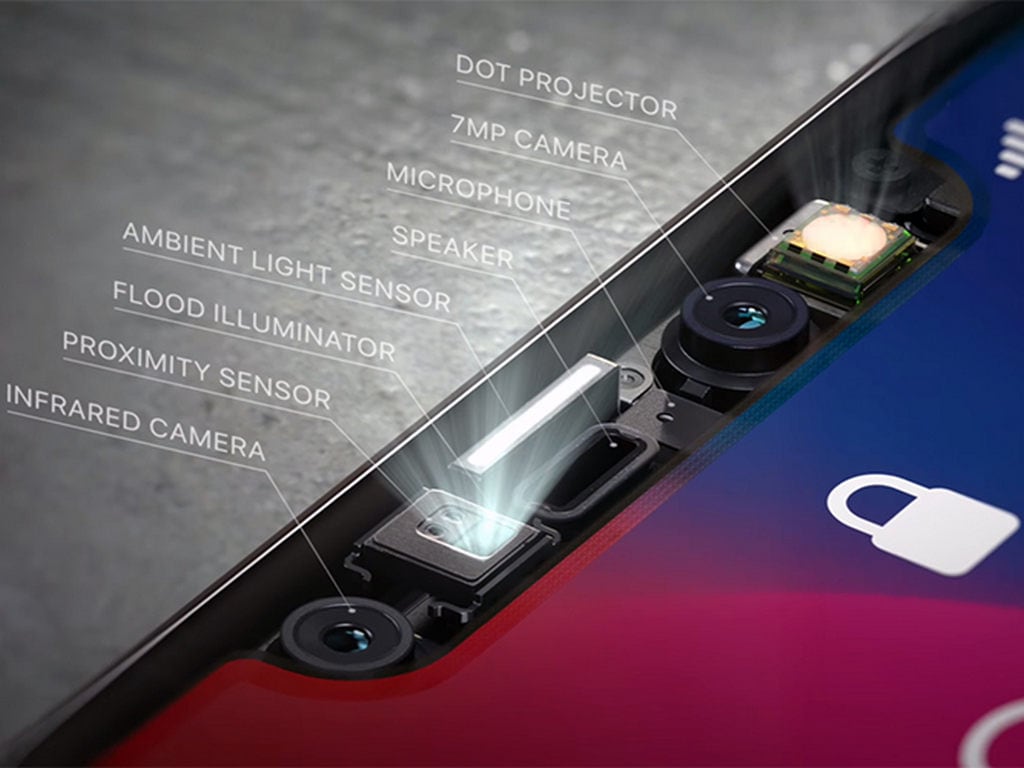
Face ID on the iPhone X. Image
This might finally change with Android Q. As per a discovery by XDADevelopers, Google may finally add support for native facial recognition with Android Q. In other words, the find indicates that Android Q will likely have support for dedicated facial recognition sensors, rather than the current front-facing camera-based solutions.
This will make it much simpler for Android OEMs to implement sensors. This also means that we will likely see Android One smartphones running Android Q feature facial recognition sensors in the future.
The report also adds that similar to existing biometric authentication methods, the new facial recognition will fall back onto a PIN, password, or pattern as backup.
9to5Google also noticed that it interfaces with the same biometric dialog rolled out in Android Pie. As a result, this new system will likely be able to be used for purchases, as well, which is an added bonus.
Tech2 is now on WhatsApp. For all the buzz on the latest tech and science, sign up for our WhatsApp services. Just go to Tech2.com/Whatsapp and hit the Subscribe button.
tech2 News Staff Jan 27, 2019 10:54:58 IST
WhatsApp constantly gets new features and the latest beta version being rolled out introduces a new emoji layout and also brings fingerprint and Face ID recognition to the popular messaging service.
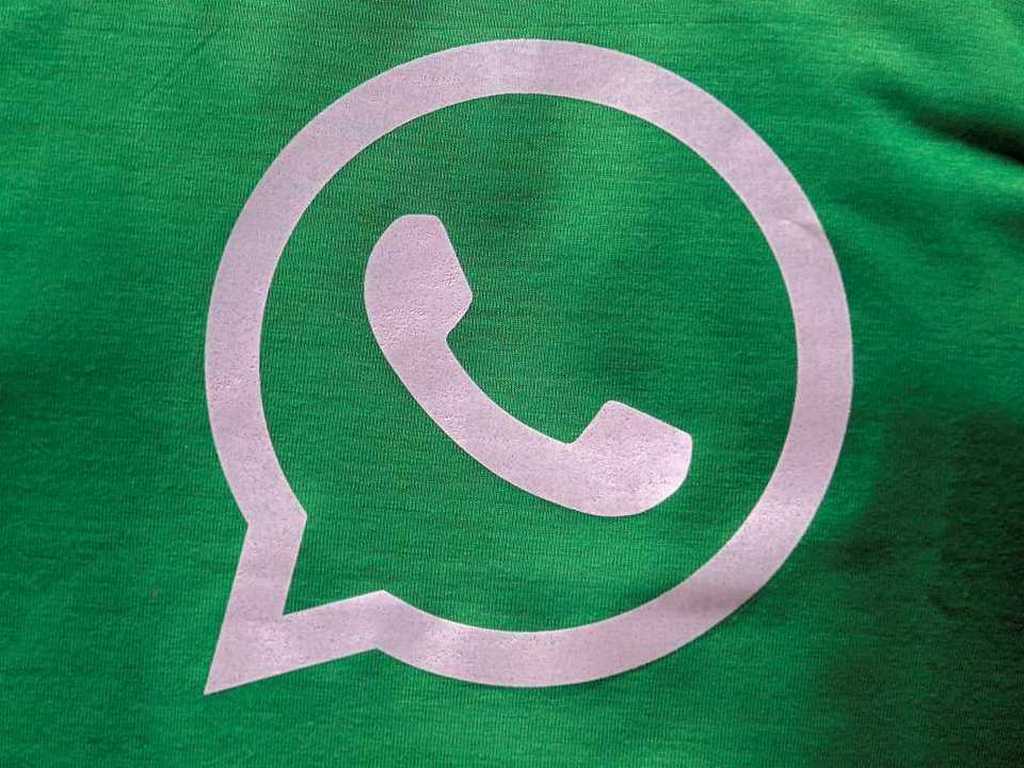
A logo of WhatsApp is pictured on a T-shirt worn by a WhatsApp-representative. Reuters
The latest beta version (2.19.21) submitted through the Google Play Beta Program features a new emoji layout for as many as 21 existing emojis on the Android app. You won’t notice any drastic changes here as the emojis feature minute changes in colour and design details.

WhatsApp’s new emojis compared to existing emojis. Image: WABetaInfo
As per a blog post by WABetaInfo, a source known to closely track WhatsApp related changes, the messaging giant was found to be working on an update to improve the layout of all of its 357 emojis in the 2.18.384 beta update, a couple of days back. While WhatsApp did go ahead and roll out beta version 2.18.384, the update was quickly followed up with another update which reads as version 2.19.21.
In addition to the new layout, WhatsApp is also expected to add a new fingerprint and facial recognition-based authentication system with version 2.19.21. The feature does not work right now but WhatsApp is expected to remotely enable the feature once a stable version of 2.19.21 is ready.
Once activated, the feature is expected to function similar to how an app locker works. Anyone opening the app will be asked to scan his/her finger or allow the front-facing camera to authenticate the user.
As per an earlier report, WhatsApp has been working on its fingerprint authentication feature since the beginning of the month but the feature isn’t quite ready yet.
WABetaInfo also states that a bug with version 2.18.384 involving a new sticker search feature, has not been fixed in the latest update. The sticker search feature was introduced in version 2.18.384, but fails to show up once the app is closed.
Given WhatsApp’s active beta program, it shouldn’t be long before we begin to see all these changes being implemented and rolled out in a stable version of the app.
Tech2 is now on WhatsApp. For all the buzz on the latest tech and science, sign up for our WhatsApp services. Just go to Tech2.com/Whatsapp and hit the Subscribe button.
[unable to retrieve full-text content]
The Associated Press Jan 26, 2019 13:45:02 IST
Mark Zuckerberg’s latest attempt to explain Facebook’s data-sharing practices is notable for its omissions as well as what it plays up and plays down.
In a Wall Street Journal op-ed 24 January titled “The Facts About Facebook,” the CEO doubles down on previous talking points while leaving out, for example, a potential Federal Trade Commission investigation over its privacy practices.
Here’s look at Zuckerberg’s claims in the op-ed:
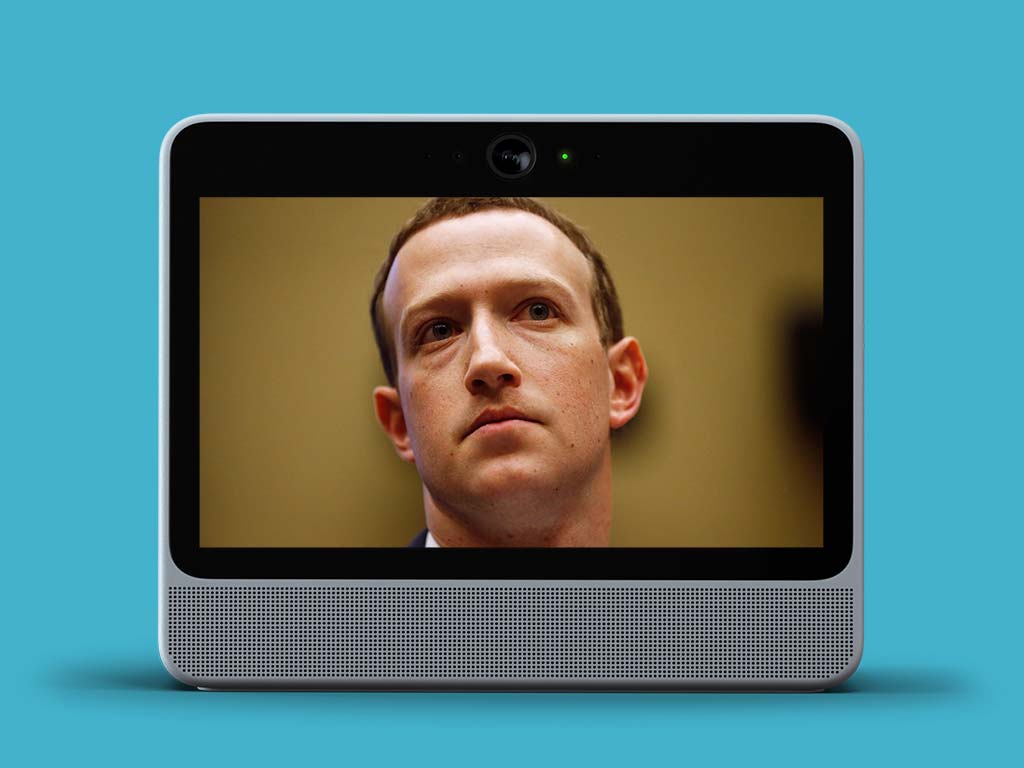
Do you really trust Facebook to safely handle your privacy?
ZUCKERBERG: “We don’t sell people’s data.” — 24 January 2019.
THE FACTS: Sure, Facebook doesn’t technically “sell” your information. Instead, it rents it out, gives it away and sometimes just doesn’t know how to protect it, as we’ve seen with Cambridge Analytica and other mishaps.
And while Facebook doesn’t sell user data directly to third parties, it makes money from the information. Advertisers choose the types of users they want to reach, based on their location, age and even their political leanings and presumed ethnicity. Facebook identifies which users fit the criteria and shows those people the ads. So technically the information stays with Facebook, but it’s used to do the advertiser’s bidding.
And as the Cambridge Analytica scandal revealed, Facebook has been sharing data with third parties. In that case, a political data-mining firm, Cambridge Analytica, managed to get data on as many as 87 million Facebook users through a personality-quiz app that was purportedly a research tool. With apps, Facebook isn’t selling data — it’s giving the data to makers of apps for free.
ZUCKERBERG: “People consistently tell us that if they’re going to see ads, they want them to be relevant.”
THE FACTS: Zuckerberg doesn’t say how people were posed this question or how the user surveys were conducted.
He does say that to comply with new European data rules, Facebook had asked users for permission to use data to improve ads. In such cases, he says, “the vast majority agreed because they prefer more relevant ads.”
But framing the issue as one of relevance to users glosses over Facebook’s business model of allowing companies to target advertisements based on people’s information.
In a recent survey of US Facebook users, the Pew Research Center found that more than half of users are “not comfortable” with Facebook compiling information about their interests for ad targeting. In a 2012 survey, Pew found that about two-thirds of internet users “disapprove of search engines and websites tracking their online behaviour in order to aim targeted ads at them.”
ZUCKERBERG: “Another question is whether we leave harmful or divisive content up because it drives engagement. We don’t…The only reason bad content remains is that the people and artificial-intelligence systems we use to review it are not perfect.”
THE FACTS: Facebook does have policies against clearly defined harmful content such as hate speech, abuse, inciting violence and other things. It’s true that Facebook’s human and AI systems are not catching all the bad stuff.
But there are also gray areas — posts that are divisive but don’t run afoul of anti-harassment policies, as well as news stories that aren’t outright fakes but misleading. Such posts typically remain available on Facebook.
Tech2 is now on WhatsApp. For all the buzz on the latest tech and science, sign up for our WhatsApp services. Just go to Tech2.com/Whatsapp and hit the Subscribe button.
[unable to retrieve full-text content]
tech2 News Staff Jan 26, 2019 14:50:51 IST
A new Google device has been spotted on Geekbench that has been listed as “Google Coral”. It is claimed to be one of the flagship models that the company might release this year.
The listing shows the phone to be running Android Q which is yet to even enter a beta testing phase or for that matter, get announced.
The Pixel 3 XL.
As per the report by GizmoChina, the phone is speculated to be an Alpha build of the Pixel 4 which might be the first device to feature Google’s next-generation operating system.
The Geekbench shows the phone to come with a 3,296 Single-Core score and 9,235 Multi-Core scores and also packs 6 GB of RAM. The score results of the Google Coral are much higher than the Google Pixel 3 XL, OnePlus 6, LG G7 ThinQ who sport a Qualcomm Snapdragon 845.

Mysterious device Google Coral spotted on Geekbench. Image: Geekbench
So there is a possibility of the latest Qualcomm Snapdragon 855 chipset to power the device.
We’ll have to wait for an official note on the device to exactly know what it’s in store for us.
Tech2 is now on WhatsApp. For all the buzz on the latest tech and science, sign up for our WhatsApp services. Just go to Tech2.com/Whatsapp and hit the Subscribe button.
[unable to retrieve full-text content]

Over the weekend, many WPML customers received an unauthorized email from someone who claimed to have hacked the company’s website and gained access to customer emails. WPML founder Amir Helzer suspects that the attacker is a former employee.
“The customer is an ex-employee who left an exploit on the server (not WPML plugin) before leaving. Besides fixing the damage, we’ll also be taking legal actions,” Helzer said Saturday night.
The WPML team worked around the clock over the weekend to secure their systems and sent out an email informing customers of the incident. They also assured customers that the WPML plugin does not contain an exploit and that payment information was not compromised. The company published an announcement to their website, detailing the incident and their response:
We updated wpml.org, rebuilt everything and reinstalled everything. We secured access to the admin use 2-factor authentication and minimized the access that the web server has to the file system.
These are more precautions than actual response to the hack. Our data shows that the hacker used inside information (an old SSH password) and a hole that he left for himself while he was our employee.
This hack was not done via an exploit in WordPress, WPML or another plugin, but using this inside information. In any case, the damage is great and it’s done already.
WPML urges customers not to click on any links in the email the attacker sent out and recommends they change their passwords for wpml.org. The attacker has customer names, emails, and sitekeys, but WPML said the sitekeys cannot be used to push changes to customer websites.
Helzer is convinced that the attack was an inside job and suspects two former employees. He and his team are working to provide evidence to the authorities. He said the the nature of the attack demonstrates that it was likely not an outside hacker:
- The first time our site was breached was on the day we fired an employee, who had access to our servers. We didn’t identify the breach at that time. However, once we got hacked, we analyzed the original hole and we found in our log when it was placed (yup, he deleted the log, but he didn’t delete the backup). Now that we finished cleaning up the mess, we’re going through all logs and collecting the full evidence.
- The attacker targeted specific code and database tables that are unique to our site and not generic WordPress or WPML tables.
- The attacker crafted the attack so that it would cause us long term damage and not be apparent in first sight. That long-term damage is very difficult to guess without knowing our business objectives and challenges. This is information that our employees have, but we don’t disclose.
The idea that a former employee who is known to the company would risk performing these illegal actions is difficult to grasp, even in the case of someone who was fired and may have been acting in retaliation. The risks of being caught seem too great.
“In many jurisdictions including the USA, this is jail time,” Wordfence CEO Mark Maunder said. “So I find it quite incredible that an employee would leave a backdoor, use it to deface their site, steal their data and email all subscribers. This is the infosec equivalent of walking into a police precinct and tagging the wall while the cops watch.”
Helzer said the incident should serve as a wakeup call for companies that employ remote workers. It highlights the importance of having procedures in place for revoking employee access to all systems used as part of day to day operations.
“We have to admit that our site was not secured well enough,” Helzer said. “If someone previously had admin access and stopped working for us, we should have been more careful and avoided this situation.
“This can be a wakeup call for others. We talk a lot about the benefits or remote work and most of the WordPress industry works remotely. This made us realize that we need to be a lot more pessimistic when we allow any access to our system.
“For example, the fact that we’re now coding for ourselves a requirement to login with 2fa, means that we’re not alone in this exposed situation.”
The attacker’s unauthorized email and WPML’s response email went out over the weekend, so many customers will be learning of the incident today when they return to work. Helzer said customers have been supportive so far.
“I think that customers appreciate the fact that we contacted them as fast as we could and we dropped everything and ran to handle this,” he said. “I think that we’ll still have damage. Clients did not run away from us right now but a good reputation is something that you build over years. A nasty incident like this stays ‘on your record.’ This is our livelihood and we take it seriously.”
tech2 News Staff Jan 26, 2019 15:51:55 IST
Huawei has also joined its fellow smartphone brands in running a Republic Day sale. Huawei has held its sale on Amazon offering the Huawei P20 Lite at a discounted price from 25 January till 31 January. The Chinese smartphone brand is also is giving a free gift with its recently launched Huawei Y9, but it is not available at a discounted price.
The Huawei P20 Lite gets a discount of Rs 7,000 from its launch price of Rs 19,999 and will be available during the sale at Rs 12,999.
In addition to the price drop, customers can also avail the no-cost EMI purchase by using an HDFC Bank credit card. Also, an instant discount of 5 percent can be availed by using an ICICI bank card.
The gift that the Huawei Y9 buyers will be bestowed with is a Boat Rockerz 255 Sports Bluetooth headset worth Rs. 2,990. The Huawei Y9 will be up for sale for Rs 15,990
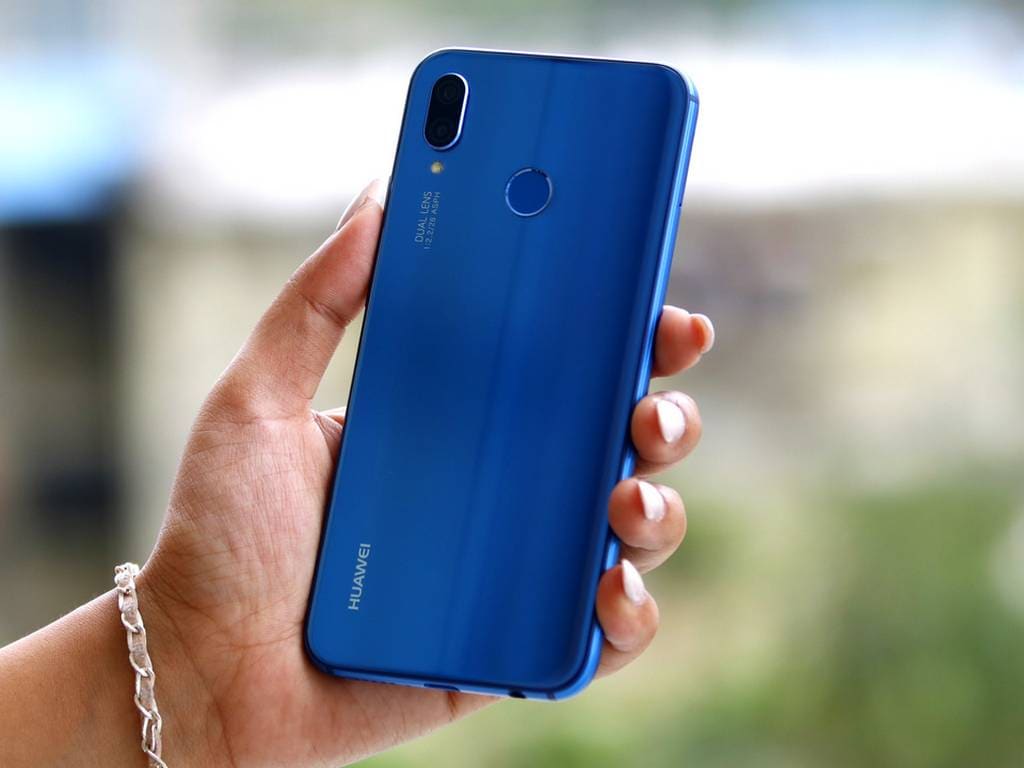
The Nova 3 looks like a larger Huawei P20 Lite. Image: tech2/ Prannoy Palav
The P20 Lite features a 5.84-inch IPS LCD display with a resolution of 1080×2280 pixels. Under the hood, the device has a HiSilicon Kirin 659 SoC alongside 4 GB of RAM and 32 GB or 64 GB of internal storage.
The device sports a dual-camera at the back with 16 MP + 2 MP setup alongside a LED flash. At the front, there is a 16 MP camera with f/2.0 aperture which can record videos in 1080p.
In terms of connectivity, it has a dual-SIM slot with 4G VoLTE connectivity. Apart from that, it comes with Wi-Fi 802.11 b/g/n, Bluetooth 5.0, GPS, and a reversible USB type-C port. The P20 lite has a 3,000 mAh battery.
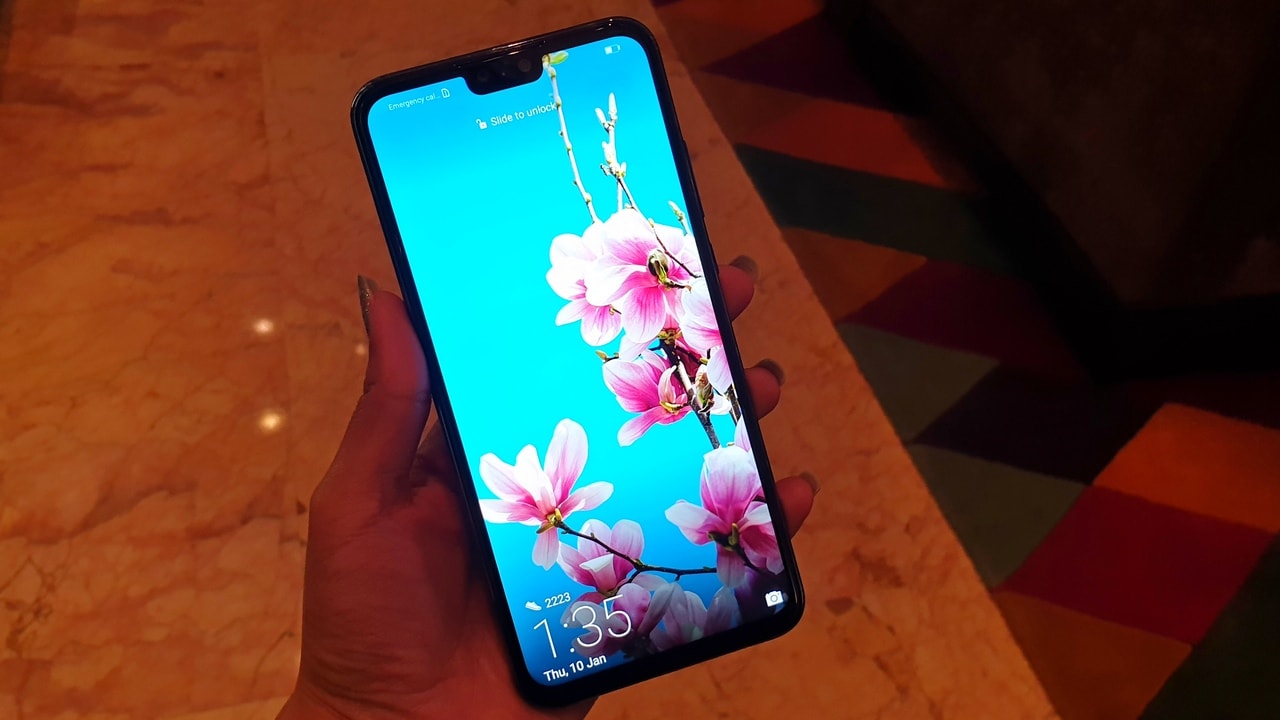
The Huawei Y9 (2019). Image: Tech2/Nandini Yadav
The device features a 6.5-inch IPS LCD capacitive touchscreen display with 1080 x 2340 pixels.
The Huawei Y9 (2019) is powered by a Hisilicon Kirin 710 (12 nm) CPU processor and is available in a single storage variant in India — 4 GB RAM with 64 GB storage. The memory can be expanded using microSD up to 400 GB.
In terms of optics, it has a dual camera at the back with a 13 MP primary sensor with a 2 MP secondary sensor. Up front, the device features a dual camera set up as well — 16 MP and a 2 MP depth sensor.
Videos can be shot on 1080p at 30 fps and 1080p at 30 fps. There is an LED flash and there is support for HDR, panorama and HDR.
There is a fingerprint mounted on the rear.
It runs Android 8.0 Oreo coupled with EMUI 8.2, and is powered by a 4,000 mAh non-removable Li-Ion battery.
The colours include — Midnight Black, Sapphire Blue, Aurora Purple.
Tech2 is now on WhatsApp. For all the buzz on the latest tech and science, sign up for our WhatsApp services. Just go to Tech2.com/Whatsapp and hit the Subscribe button.